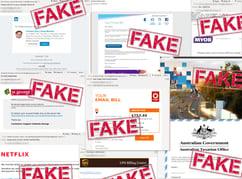When you consider how central email is to daily business operations, it’s not surprising, that it’s become the most damaging weapon in the cybercrime arsenal.
Every business still relies on email to do the majority of their daily communication. Everything from stationery orders to corporate mergers is organised and negotiated through the humble inbox.
A Radicati survey examining email use found that the worldwide volume of emails sent daily is growing at a rate of 4.4% and is expected to reach 319.6 billion messages a day by the end of 2021.
Data from FBI reports shows that email-based attacks like CEO fraud and phishing are by far the most costly cybercrime categories.
The US DHS - Dept. of Homeland security - recently directed all US government agencies to enhance their email protection protocols and announced a new division of the DHS to deal exclusively with cybersecurity threats. DHS Secretary Nielsen stated in the announcement that cybersecurity threats “now pose an even bigger threat to national security than physical threats.”
Australian companies targeted
 The 2018 AusCERT report found that organised crime is responsible for around 50% of cybersecurity incidents in Australia.
The 2018 AusCERT report found that organised crime is responsible for around 50% of cybersecurity incidents in Australia.
“Australian Businesses are targets and are generally underprepared,” AusCERT states in their report. “Phishing and email attacks are still the most prevalent form of cyber security incidents affecting respondents... Phishing emails are the most widely used infection vector employed by 71% of all threat actor groups.”
The ASBFEO, Australia’s small business advocate, released survey figures in 2017 that illustrate the severe damage cyber-attack can do to SMBs. The ASBFEO reported that 43% of cybercrime attacks target smaller businesses, not large corporations and that 60% of small companies hit with a cyber-attack are so badly affected that they go out of business within six months.
Every team member is vulnerable

People are the most cybercrime-vulnerable part of a company, which is why criminals use email to attack. The average person sitting at a desk has little or no understanding of cybercrime techniques, so they don’t know what to look out for.
One well-crafted email is all a cybercriminal needs to get inside a company’s defences. They’ll send millions of messages to random inboxes, using tricks like fake notification messages made to look like they come from big, recognisable companies. The criminals objective is to trick an unwary person to click on a link and submit their password details or download a file infected with spyware. With those simple tricks, hackers can get inside a company’s computer system and access all kinds of valuable data like contact lists and financial files.
Read more about the deceptive techniques used by cybercriminals in this article by MailGuard CEO Craig McDonald:
The imitation game: email fraud, phishing & brandjacking.
Email security is vital
All criminals need to break into your business is a cleverly worded phishing email. If they can trick one person in your company into clicking on a malicious link they can gain access to your data.
Securing your inboxes is the most important step toward protecting your company from the threat of data breaches.
For a few dollars per staff member per month, you can protect your business with MailGuard's predictive email security.
Talk to an expert at MailGuard today about making your company's network secure: click here.
Cybersecurity explained
If you would like to learn more about the complex cybersecurity challenges facing business today, please download the e-book Surviving the Rise of Cybercrime by MailGuard CEO Craig McDonald. This plain English handbook explains the most common threats and provides essential guidance on managing risk.

"Cybercrime is a serious and growing business risk. Building an effective cybersecurity culture within an organisation requires directors and executives to lead by example. Surviving the Rise of Cybercrime is a must-read for directors and executives across business and in government and provides strong foundations for leaders determined to address cyber risk.” - Rob Sloan, Cybersecurity Research Director, Wall Street Journal.
Download your copy of Surviving the Rise of Cybercrime for free, here.






